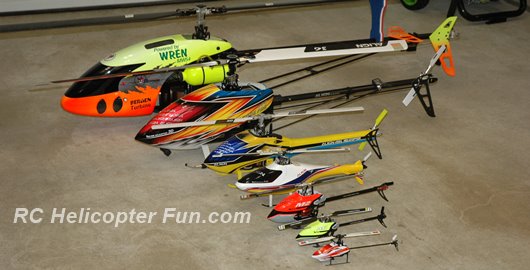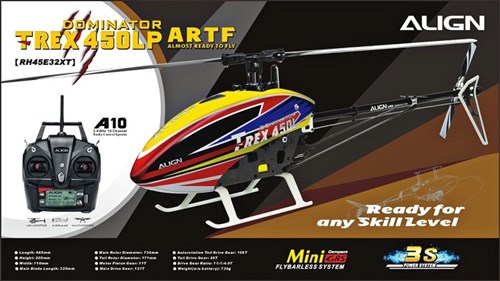LARGE RC HELICOPTERS
How Are RC Helicopters Sized & What Is The Best Size To Start With?
by John Salt - Last Updated July 2025
Size is a "big" topic. Many people say large RC Helicopters are the best to learn on once you make the fun progression to single rotor collective pitch. "Bigger is better" in other words.
That used to be true with flybars, but not to the same magnitude now with the help of flybarless electronic stabilization. No question, the larger the RC helicopter, the more stable it is, but it's not a night and day difference like it used to be in the good old flybar days.
Problem is, just what is considered "large", and for that matter, how are RC helicopters even sized so you know what to look for?
Sizing RC Helicopters By Engine/Motor Size
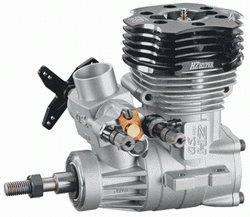 30 size nitro RC helicopter engine
30 size nitro RC helicopter engineBack when I got started in the hobby (late 80's), when all we had were nitro RC helicopters, sizing RC planes and helicopters was fairly easy and consistent. Basically whatever size nitro engine was used in the helicopter, that’s what size it was referred to.
A 30 size RC helicopter for example would use a 30 size nitro engine.
With different power options now such as electric and turbine, how on earth can we compare apples to apples?
For instance, a 30 size nitro heli is about the same size a 550 class electric RC helicopter.
Would someone new to the hobby understand that 30 is the same as 550? I've been at this for over 30 years and it makes little sense to me either.
Moreover, electric motor specifications and numbers are all over the place and arbitrary at best.
Nano, micro, and mini helicopter sizing has also clouded the issue with these terms being thrown around more as marketing tools than as accurate ways to determine helicopter size.
Confusing – You bet!
Fortunately there is a much better and consistent way to determine sizing from small RC helicopters up to large RC helicopters, and that is by the size of the main rotor blades.
Sizing RC Helicopters By Main Blade Size
All good RC helicopter manufacturers should indicate both main rotor length & main rotor diameter on their specifications of each helicopter model.
This way you can compare apples to apples without getting lost in engine or motor numbers.
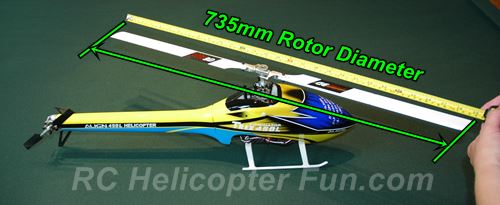 400 Size RC Helicopter
400 Size RC HelicopterThe main rotor diameter as shown above is simply the distance measured from rotor tip to rotor tip. 735mm on this particular 400 size RC helicopter. The individual blade length is 330mm. Why 330 on a 400? Thank marketing for that one; some manufacturers round the size up - substantially!
The main rotor blade length is measured from main rotor mounting bolt hole out to the tip of the rotor blade.
This blade length method of sizing is finally starting to become the standard. Thus, a 700mm long rotor blade as shown below, is used on a 700 size RC helicopter.
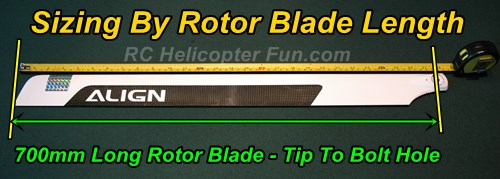 700mm Long Rotor Blade Is Used On 700 Size RC Helicopters.
700mm Long Rotor Blade Is Used On 700 Size RC Helicopters.I have broken this mess of sizing down to four basic RC helicopter sizes (classes): Micro. Small. Medium. Large.
Under each size heading, I have included rotor blade length & diameter range in millimeters and inches; as well as several popular helicopters in each size range so you can get a better of idea actual sizes along with pros and cons of each size class.
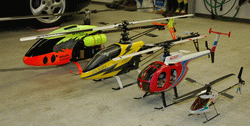
Hopefully this will help you get your head around all this large RC helicopter vs small RC helicopter talk by pointing out some relative scale and examples.
1: Nano / Micro RC Helicopters
- Helicopter Size Class: 100 - 200
- Main rotor blade length: 100mm - 130mm (3" - 5")
- Main rotor diameter: 150mm – 300mm (6" – 12")
- Electric only, too small for nitro, gas, or turbine
- Example helicopters:
XK K110 main rotor dia. = 245mm
Align T-Rex T15 main rotor dia. = 281mm
OMP Hobby M1 main rotor dia. = 290mm
GooSky S1 main rotor dia. = 290mm
 Micro Size Blade mCP RC Helicopter
Micro Size Blade mCP RC HelicopterPros:
- Inexpensive (helicopter, batteries, parts).
- Very crash resistant due to very low mass & low energy release.
- Can fly "tamely" indoors in average sized rooms.
- Can fly "aggressively" outdoors in smaller yards calm conditions.
- Generally don't fall under new RC flying regulations & restrictions.
- Low parts count.
- Very safe and non intimidating to self learn on.
- Already built.
Cons:
- Hardest to see.
- Can be quite "squirrely" due to low mass & fast reaction.
- Short flight times.
- Some are low quality & fragile making them fairly disposable.
- Hard to work on due to small size.
- Can't auto-rotate.
- Many (not all) have fairly short product runs - long term ownership outlook is poor (a year or two).
2: Small RC Helicopters
- Helicopter Size Class 200 - 300
- Main rotor blade length: 130mm - 300mm (5" - 11")
- Main rotor diameter: 300mm – 600mm (12" – 24")
- Almost all electric however there have been a couple 0.049 nitro powered helis over the years in this size (too small for gas or turbine)
- Example helicopters:
OMP Hobby M2 EVO main rotor dia. = 434mm
GooSky S2 main rotor dia. = 440mm
Blade 230 S main rotor dia. = 536mm
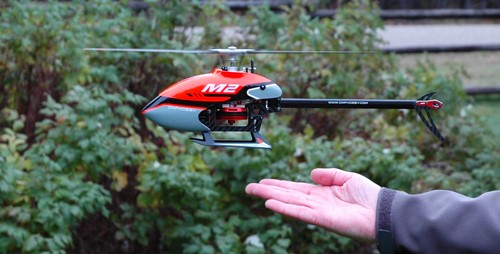 Small Size OMP Hobby M2 RC Helicopter
Small Size OMP Hobby M2 RC HelicopterPros:
- Somewhat inexpensive (helicopter, batteries, parts).
- Crash resistant to a point, damage is likely under higher speed/energy crashes.
- Can fly indoors in very large rooms / gymnasiums.
- Can fly outdoors and in light to moderate wind.
- Nice size to fly in average to large size yards.
- May not fall under new RC flying regulations & restrictions.
- Low parts count.
- Fairly safe & non intimidating to self learn on.
- Already built.
- Most have moderate length product runs - long term ownership outlook is fair (several years).
Cons:
- Hard to see at moderate distances.
- Can be a little hard to work on due to small size.
- Hard but not impossible to auto-rotate.
3: Medium RC Helicopters
- Helicopter Size Class 400 - 500
- Main rotor blade length: 300mm - 500mm (10" - 20")
- Main rotor diameter: 600mm – 1200mm (24" – 47")
- Almost all electric but there have been some 0.10 – 0.20 (10-20 nitro) powered helis in this size over the years.
- Example helicopters:
Align T-Rex 450L - main rotor dia. = 804mm
GooSky RS4 - main rotor dia. = 872mm
OMP Hobby M4 - main rotor dia. = 875mm
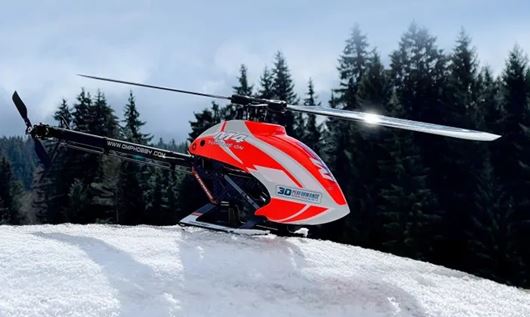 Medium Size OMP Hobby M4 RC Helicopter
Medium Size OMP Hobby M4 RC HelicopterPros:
- Usually best overall value in terms of most rotor size per dollar ratio of all sizes.
- Parts don't cost that much more than many small size heli parts.
- Stable and predictable.
- Longer flight times.
- Easy to see at moderate distances.
- Can handle a fair amount of wind.
- Fairly easy to work on.
- Because most are kits, people learn a lot with this size of helicopter from both a mechanical and electronic standpoint that will help them with larger helicopters. It has been my experience for example, that most people who can confidently work on, fly, and maintain a heli of this size; are then well prepared and can successfully progress to any of the larger sizes armed with a solid skill base and understanding.
- Higher quality parts last longer as do the helicopters.
- Most use very common and easy to find size and voltage LiPo batteries (largely because these are such common size helis).
- Very broad envelope of flying performance right from beginner skill sets up to hard core 3D smacking.
- Some scale fuselages available if scale is your goal.
- A really nice size almost all people enjoy flying.
Cons:
- A crash will almost always result in broken parts due to higher mass and energy.
- Pretty safe but can cause damage to both body and property if you hit someone/something.
- Generally fall under new RC flying regulations & restrictions.
- Can be difficult to auto-rotate.
- Most have moderate length product runs - long term ownership outlook is fair (several years).
4: Large RC Helicopters
- Heli Size Class: 550 and larger.
- Main rotor blade length: 550mm and up (20" +)
- Main rotor diameter: 1200mm and up (47" +)
- Electric Motor Size: 550 and up.
- Combustion engine size: 0.3 – 0.9 (30-90 nitro) / 20cc and up (gas) / 6 hp and up (turbine)
- Example helicopters:
Align Trex 550X - main rotor dia. = 1188mm
SAB Goblin Kraken 580 - main rotor dia. = 1290mm
Align TB60 - main rotor dia. = 1340mm
Align TB70 V2 - main rotor dia. = 1542mm
Align Trex 800 - main rotor dia. = 1780mm
Bergen Intrepid Turbine - main rotor dia. = 1800mm
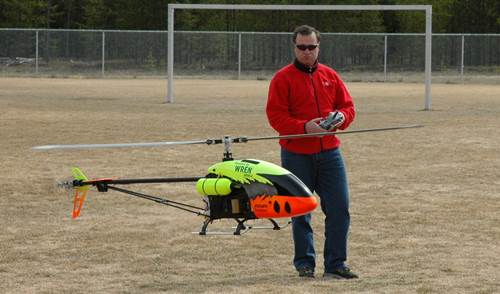 The 810 Size Bergen Intrepid Turbine Is A Heavy Beast But So Engaging.
The 810 Size Bergen Intrepid Turbine Is A Heavy Beast But So Engaging.Pros:
- Best flying engagement experience.
- Best visual experience of all sizes - very easy to see. Usually puts on the best air show for spectators.
- Best rotor blade noise produced. "Blade barking" once you get into the 700 and larger sizes starts getting similar to some smaller performance full size helicopters. For many (myself included), this is one the best "sense stimulating" aspects of flying RC helicopters.
- Immensely rewarding to build, fly, & maintain.
- Many power options available (electric, nitro, gas, turbine).
- Many fuselage options and full scale kits if you want to get into scale RC helicopters.
- They "fly big" with lots of mass and inertia. Very predictable, stable, and fluid smooth.
- Can have long flight times.
- Big outdoor environment flying - need lots of room to appreciate full flight potential & stay safe.
- Can handle wind no problem.
- Pretty easy to auto-rotate, but some are heavy buggers so timing has to be perfect.
- Higher quality parts last longer as do the helicopters.
- Huge amount of component options allowing people to customize their builds based on budget & upgrade/update if/when they choose.
- All come in kit form and you have
to build them.
- Very broad envelope of flying performance from scale to high energy/power hard core 3D. Ultra fluid F3C due to the increased mass and inertia.
- Capable of flying very fast.
- Long product runs due to high development costs - long term ownership outlook is good (many years).
Cons:
- Price jumps substantially over the medium sizes. Costs are generally at least double for the helicopter, components, parts, engine/motor/ESC, fuel, batteries, etc.
- Crash repairs on one of these larger RC helicopters can easy cost as much or more as an entire small or medium heli costs. Main blades alone can be upwards of $300. A bad crash can be upwards of of $1000 in repair costs.
- Not good for self learning on; instructor or experienced pilot help mandatory!
- A crash will always result in broken parts due to higher mass and energy release.
- Dangerous. Heli's of this size & power are capable of causing substantial property damage, injury, and even death.
- Increased flying stress & worry.
- May require special or additional insurance.
- Fall under new RC flying regulations & restrictions.
- Requires access / permissions to large, legal open areas to fly (RC flying clubs, big open fields/farms, etc.).
Best RC Helicopter Size To Self Learn On
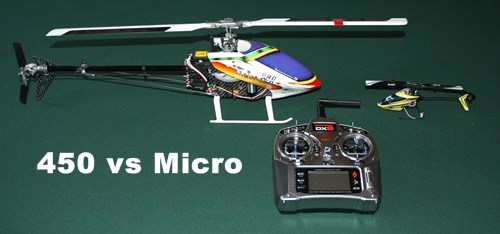 Medium vs Micro RC Helicopter Size
Medium vs Micro RC Helicopter SizeNow that we have our 4 basic sizes identified let's look at which will be your best collective pitch RC helicopter to first learn on.
For self learning, generally the best two heli sizes for most newbies are what I have classified as Micro or Small. More RC heli pilots have recently & successfully self learned to fly on these two size classes than all others.
Micro 100 size collective pitch RC helicopters like the XK K110, OMP M1 and GooSky S1 do have certain limitations however so keep them in mind.
The obvious ones are fairly short flight times, they get small very fast, are finicky to work on, can also be twitchy and don't like much wind. Better electronic flybarless stabilization these days has certainly helped with those last two issues - to a point.
With their low cost, low parts count and very good crash resistance when flown over a nice thick lawn, this size is not intimidating yet still very fun. I personally find them a lot more fun then time spent on a simulator and it's very convenient when you can fly a little micro heli in your own yard any time you wish.
Next recommendation for self learning collective pitch on would be the small size 200 class like the OMP M2 in its various versions and the GooSky S2. Both are topping this list right now - amazing birds!
These two helicopters are incredibly stable & predictable considering their small size; not far off the medium and large RC helicopters in many respects thanks again to their electronic flybarless systems.
200's are a great size for large yards, acreages and small parks (if allowed) plus they can handle wind pretty well. For large flying fields however, they do get small fast so pick a nice bright colored canopy (goes for all helicopters) and that helps.
Self Learning On Medium Size RC Helicopters - Doable.
If you've seen my Best RC Helicopter Page, then you know I'm somewhat biased toward 400 size / medium size RC helicopters to learn on, but not as much for self learning on. I simply enjoy instructing on this size more than others.
If your eyes aren't that great and you really wanted something larger than a 200, going to this next "medium" size step is doable as your first collective pitch helicopter provided you fully understand what you are getting into, tame it down and follow a ground up lesson plan.
Learning On Large RC Helicopters - Instructor Needed.
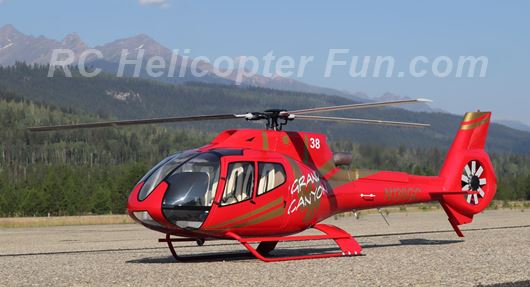 My 800 Size Scale EC130 Ready On The Flight Line
My 800 Size Scale EC130 Ready On The Flight Line180 degrees on the other end of the micro to medium heli size spectrum we get into the large birds.
I recall getting an email from a fellow a while back who lived in the Reno Nevada area who was just getting into the hobby. He didn't want to self learn but would rather learn from an instructor to speed up the process.
So, he joined the local RC helicopter flying club and signed up for lessons. They would not instruct him on anything smaller than a 600 size RC helicopter but were really pushing toward a 700 and that's what he ended getting as his very first RC helicopter and is what he took his lessons on from day one; very successfully I might add.
Why did they want to start him out on such a large RC helicopter? Well, it's almost always windy in Reno, and in that case getting a big & stable bird to learn on makes good sense. Flight times are also quite long making each training flight more beneficial to the student while maximizing the instructors training time with the student.
I would never recommend for anyone to "self learn" on such a large RC helicopter due to the dangers and costs involved; but with an instructor's help, those concerns are very much minimized.
This is exactly why I point out on my best RC helicopter page, there is no "best size" to learn on for everybody as it's all dependent on flying location, how you learn to fly, and naturally your budget.
May as well end this RC helicopter sizing topic off with a couple large RC heli videos. First is the largest RC helicopter currently in my fleet, an 800 size scale EC130. Followed by one of the largest RC helicopters in the world. A turbine powered scale EC145.
